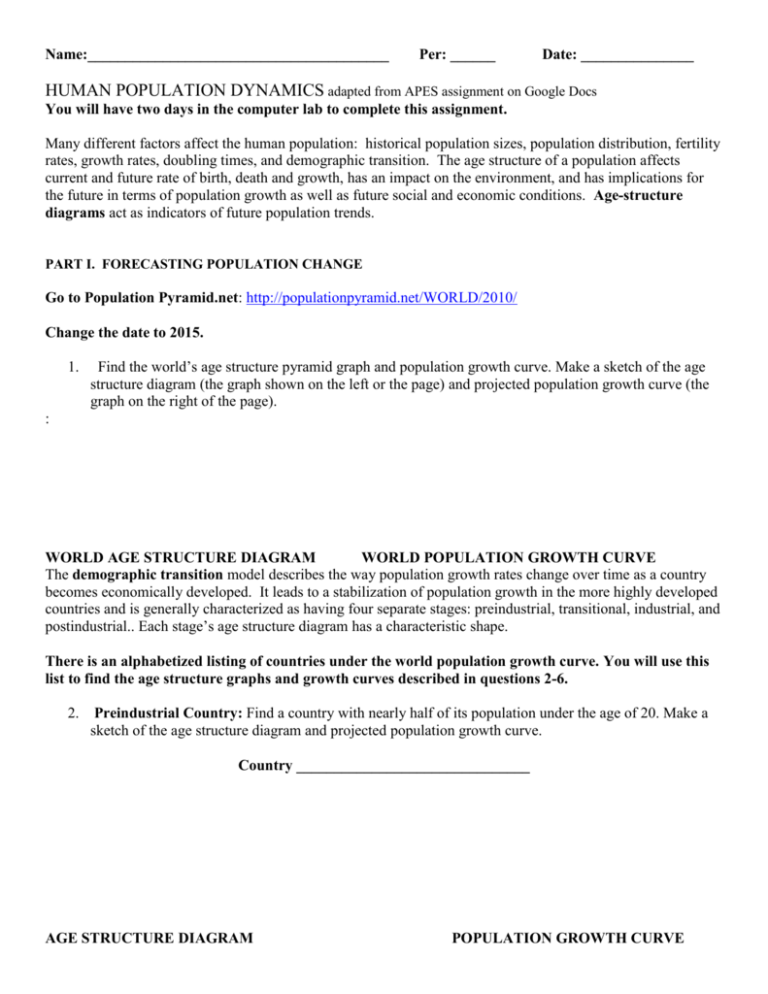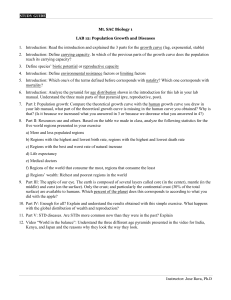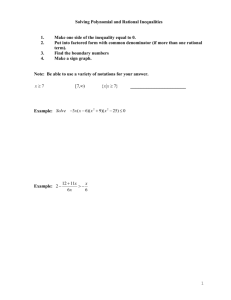Go to Population Reference Bureau Website:
advertisement

Name:________________________________________ Per: ______ Date: _______________ HUMAN POPULATION DYNAMICS adapted from APES assignment on Google Docs You will have two days in the computer lab to complete this assignment. Many different factors affect the human population: historical population sizes, population distribution, fertility rates, growth rates, doubling times, and demographic transition. The age structure of a population affects current and future rate of birth, death and growth, has an impact on the environment, and has implications for the future in terms of population growth as well as future social and economic conditions. Age-structure diagrams act as indicators of future population trends. PART I. FORECASTING POPULATION CHANGE Go to Population Pyramid.net: http://populationpyramid.net/WORLD/2010/ Change the date to 2015. 1. Find the world’s age structure pyramid graph and population growth curve. Make a sketch of the age structure diagram (the graph shown on the left or the page) and projected population growth curve (the graph on the right of the page). : WORLD AGE STRUCTURE DIAGRAM WORLD POPULATION GROWTH CURVE The demographic transition model describes the way population growth rates change over time as a country becomes economically developed. It leads to a stabilization of population growth in the more highly developed countries and is generally characterized as having four separate stages: preindustrial, transitional, industrial, and postindustrial.. Each stage’s age structure diagram has a characteristic shape. There is an alphabetized listing of countries under the world population growth curve. You will use this list to find the age structure graphs and growth curves described in questions 2-6. 2. Preindustrial Country: Find a country with nearly half of its population under the age of 20. Make a sketch of the age structure diagram and projected population growth curve. Country _______________________________ AGE STRUCTURE DIAGRAM POPULATION GROWTH CURVE 3. Transitional Country: Find a country with a declining birth rate and a declining population. . Make a sketch of the age structure diagram and projected population growth curve. Country _______________________________ AGE STRUCTURE DIAGRAM POPULATION GROWTH CURVE 4. Industrial Country: Find a country with a high percentage of elderly in its population. Make a sketch of the age structure diagram and projected population growth curve. Country _______________________________ AGE STRUCTURE DIAGRAM POPULATION GROWTH CURVE 5. Postindustrial Country: Find a country with a stable population size (close to zero population growth). Make a sketch of the age structure diagram and projected population growth curve. Country _______________________________ AGE STRUCTURE DIAGRAM POPULATION GROWTH CURVE 6. Column with a Budge Shape: Sometimes countries experience booms in populations and their age structure diagrams resemble a column with a bulge. Find a country with this shape and make a sketch of the age structure diagram and projected population growth curve. Country ___________________ AGE STRUCTURE DIAGRAM POPULATION GROWTH CURVE You have looked at several shapes of age structure diagrams: pyramid, column, inverted pyramid, and column with a bulge. 7. Which shape of age structure diagram is associated with a population with the potential to grow rapidly? 8. 9. Which shape of age structure diagram is associated with a population that is slowing down in growth? Which shape of age structure diagram is associated with a population that has some event in the past that caused a high birth rate or death rate for some group but not others? 10. Which type of pyramid goes with each of the following types of countries? a. Preindustrial b. Transitional c. Industrial d. Postindustrial Go to part II on the back of this page. PART II: WORLD POPULATION GROWTH Go to Population Reference Bureau Website: http://www.prb.org/Publications/Datasheets/2013/2013-worldpopulation-data-sheet/infographic.aspx Launch the infographic. Click on the “infographic” link twice. (It is in blue type and takes a minute to load.) Click on Factors that Affect Population Growth You will scroll through this page to answer the following questions. 1. List and describe the three factors that affect population growth. 2. What is TFR? 3. Search the internet to find a definition for TFR Scroll down on the website page. 4. What region of the world has the lowest TFR? (number under the circle) 5. What country in that region has the lowest TFR? (Click on the region for this information. It will appear below the circles.) What is the TFR for this region? 6. What region of the world has the highest TFR? (number under the circle) 7. What country in that region has the highest TFR? (Click on the region for this information. It will appear below the circles.) What is the TFR for this region? 8. Explain what these numbers represent in you based on what you have learned so far. Scroll down on the website page. 9. How do the following compare between Niger and The Netherlands? Niger Netherlands __________ Lifetime Births/Woman ____________ ___________ Life expectancy at Birth ____________ ___________ Infant Mortality Rate ____________ Scroll down on the website page. 10. List the five most populous cities and their populations. Scroll down on the website page. (Click on the “i” in the upper left hand corner.) 11. Do developed or undeveloped countries have the greatest population increases? List five characteristics of these countries. 1. Scroll down and read the section on Wealth Disparities. Summarize what this paragraph says. 2. Scroll down and look at the graphs for Cambodia and Uganda on the next page. These graphs show the number of births for the five income levels listed on the x-axis. What trend do you see in these graphs? 3. Summarize what you have learned during this computer lab.




